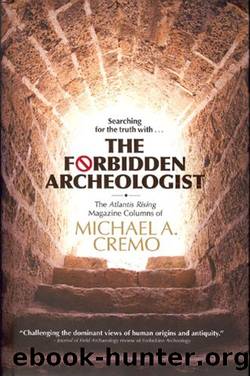The Forbidden Archeologist by Michael A. Cremo

Author:Michael A. Cremo [Cremo, Michael A.]
Language: eng
Format: epub
Tags: Civilization, Human evolution, Science, Archaeology - Philosophy, Prehistoric, Archaeology - Social aspects, Evolution, Social Science, Archaeology - Political aspects, Ancient, Paleontology, Anthropology, Michael A. - Travel, Cremo, Life Sciences, Excavations (Archaeology), Archaeology
ISBN: 9780892133376
Publisher: Torchlight Publishing Inc
Published: 2011-03-10T16:00:00+00:00
So who were these mastodon hunters? According to current views, anatomically modern humans, humans like you and me, go back one- or two-hundred-thousand years at most. Before that there were no humans like us. So perhaps the San Diego mastodon hunters were representatives of Homo erectus. Even that would be quite revolutionary, because according to current ideas that apeman never came to the New World. But if we go beyond the evidence mentioned in the current textbooks, we see that there have been archeological discoveries indicating the presence of anatomically modern humans in the New World that go back two- or three- hundred-thousand years or more.
I have already mentioned the butchered mammoth bones found by George Miller in the Anza Borrego Desert, not so far from San Diego. These bones, like the State Highway 54 mastodon, yielded an age of 300,000 years. Furthermore, in the 1970s, American archeologists working at Hueyatlaco, near Puebla in Mexico, found artifacts of the type that archeologists routinely attribute only to anatomically modern humans. The archeologists called in a team of geologists to date the site. Mammal bones with butchering marks were found in the same layers as the stone tools. The bones were dated using the uranium series method. According to a report published in Quaternary Research (1981, vol. 16, pp. 1â17), the age of the butchered bones was 245,000 years. (Actually, it was Virginia Steen-McIntyre, one of the geologists involved in dating the Hueyatlaco site who sent me the copy of the report on the State Highway 54 discoveries.) In the early twentieth century, the Argentine paleontologist Florentino Ameghino reported the discovery of an anatomically modern human skull in an excavation at Buenos Aires (Forbidden Archeology, pp. 413â418). It came from a formation that modern geologists say is about one million years old. And if you really want to go back, there are the California gold mine discoveries reported by J. D. Whitney, chief government geologist of California, in the year 1880, in a book published by Harvard Universityâs Museum of Comparative Zoology (The Auriferous Gravels of the Sierra Nevada of California). Those human bones and artifacts go back to the Eocene, the geological period that extends from 38â55 million years ago.
The State Highway 54 discoveries are not very well known because they can only be found in an obscure report in the files of the California Department of Transportation. Because state and federal laws now mandate that there must be archeological and paleontological reports in connection with road construction and other construction projects, there are thousands of such reports, and who knows whatâs in them. Somehow, because of some inside connections, I got wind of this particular report, which gives evidence that humans were in California over 300,000 years ago. I wondered what they called California back then.
Download
This site does not store any files on its server. We only index and link to content provided by other sites. Please contact the content providers to delete copyright contents if any and email us, we'll remove relevant links or contents immediately.
| Africa | Americas |
| Arctic & Antarctica | Asia |
| Australia & Oceania | Europe |
| Middle East | Russia |
| United States | World |
| Ancient Civilizations | Military |
| Historical Study & Educational Resources |
The Bomber Mafia by Malcolm Gladwell(1180)
Submerged Prehistory by Benjamin Jonathan; & Clive Bonsall & Catriona Pickard & Anders Fischer(1162)
Facing the Mountain by Daniel James Brown(1131)
The Dawn of Everything by David Graeber & David Wengrow(1105)
The Way of Fire and Ice: The Living Tradition of Norse Paganism by Ryan Smith(1032)
Wandering in Strange Lands by Morgan Jerkins(1014)
Driving While Brown: Sheriff Joe Arpaio Versus the Latino Resistance by Terry Greene Sterling & Jude Joffe-Block(1002)
Tip Top by Bill James(1002)
Evil Geniuses: The Unmaking of America: A Recent History by Kurt Andersen(999)
Red Roulette : An Insider's Story of Wealth, Power, Corruption, and Vengeance in Today's China (9781982156176) by Shum Desmond(997)
F*cking History by The Captain(966)
It Was All a Lie by Stuart Stevens;(940)
White House Inc. by Dan Alexander(904)
Evil Geniuses by Kurt Andersen(901)
Treasure Islands: Tax Havens and the Men who Stole the World by Nicholas Shaxson(879)
American Dreams by Unknown(857)
American Kompromat by Craig Unger(847)
The Fifteen Biggest Lies about the Economy: And Everything Else the Right Doesn't Want You to Know about Taxes, Jobs, and Corporate America by Joshua Holland(816)
The First Conspiracy by Brad Meltzer & Josh Mensch(811)
